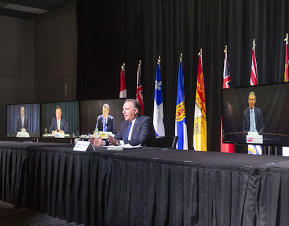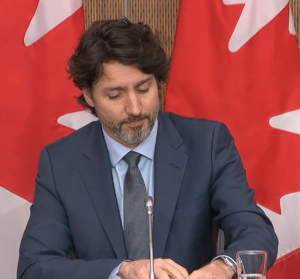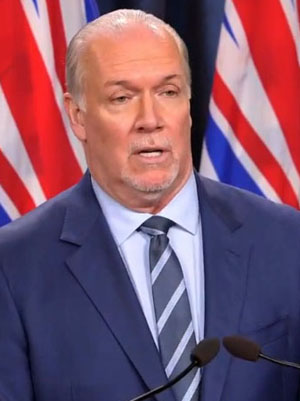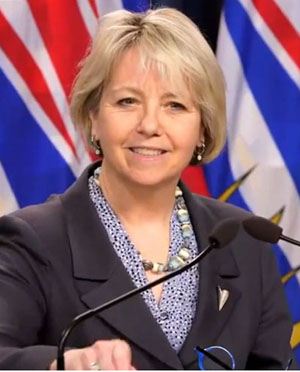
Friday March 5, 2021 | LANGFORD, BC
by Mary P Brooke, B.Sc., editor | Island Social Trends
This morning Premier John Horgan addressed the media about continuing matters of health care funding and the rollout of the BC immunization plan.
He was available for questions during his announcement about funding for the construction of 376 new student beds in the Okanagan region.
Earlier in the day, Prime Minister Justin Trudeau had said that “the priority for all Canadians is to get through this pandemic and that’s something that applies to Premiers as well” (as to why the federal government is not dealing with health transfers to provinces at this time).

BC’s Premier Horgan responded to Island Social Trends‘ question on this issue: “British Columbia has certainly been working very cooperatively with the federal government on a range of issues over the past number of years. But we’ve also been talking about the Canada Health Transfer that whole time. This is not something that just emerged, this is something that has been building over the past decade or more,” said Horgan.

Trudeau had continued during his COVID teleconference from Ottawa this morning: “We will be there to increase those transfers but that conversation needs to happen once we’re through this pandemic.”
Working now, and collaboratively:
And to that, Horgan told Island Social Trends: “As I said yesterday (in the Premiers meeting), there have been points in time in the development of our public health system, where governments have had to pivot, and change direction, and change course to the betterment of services to British Columbians and to Canadians. Now is one of those times. If we cannot talk about the delivery of public health care and the importance of adequate funding in the grip of a global pandemic, I don’t know when we are going to talk about it.”
Horgan continued: “We have been working collaboratively across the country in unprecedented ways. People from different political perspectives with different regional needs to come to this unified conclusion that the number one issue for Canadians is the preservation and advancement of public health care. That doesn’t mean that we’re putting aside the importance of grappling with the pandemic. We do that of every minute of every day. We’re talking today on a number of questions about how to roll out our vaccination program. Who’s going to be affected, and how we’re going to get out of this as safely as possible.
“This is a global pandemic. We’ve never done this before. I’m confident public health is making the right choices. We have before the largest immunization program in BC history,” said Horgan.
As for juggling things: “We can also do other things… the need to build infrastructure such as student housing, and… the need to address homelessness,” said Horgan in the live teleconference. “We can do many things at the same time. It does us a disservice to all of us for the federal govt to say we can only focus on one thing at a time. We have to focus on all of these things simultaneously and work together to get the outcomes that Canadians want…. that is an absolutely sustainable public health system, now and into the future.”
Local immunization, and young people:
Yesterday and earlier this week in the Premier’s riding of Langford-Juan de Fuca there was a steady line up at the local community centre for vaccinations. It was reportedly mostly health care workers, many of them young adults. Horgan didn’t comment on that scenario, as the full immunization program timeline will be formally announced next week.
Meanwhile, on the focus of young adults who are the workforce of the economy and in their reproductive years — the ones who are likely going to be the COVID long-haulers after this pandemic, Island Social Trends asked Premier Horgan as to why young adults are being left to the end of the age spectrum.

“We’ve looked at data from around the world,” said Horgan, and first chose to defend his Provincial Health Officer. “Dr Henry is adept at this. She’s an expert in this field. We are very fortunate to have her here, not just with her demeanor and her ability to communicate these complex issues, but her experience is unparalleled, quite frankly, in Canada. We are very fortunate to have Dr Henry leading our team here on the public health side.”
Then about the immunization decision making: “We’ve come to these conclusions based on the evidence. I appreciate your comment. I have a stack of correspondence three inches thick, from various organizations and individuals making the case that they or their organization should be at the top of the queue when it comes to vaccinations.”

“They are all legitimate arguments, that I would nod my head in the affirmative were not for the overwhelming evidence, that the most vulnerable — the most at risk for serious illness and death, are the aged,” said Horgan, fully in line with the BC Immunization Plan. “So we’re starting with oldest people in our community and working down.”
Complex work, bumps along the way:
Premier Horgan said today that as BC gets more supply — the AstraZeneca (approved last week by Health Canada) and the Johnson & Johnson product (announced just today as approved by Health Canada) — that’s then an opportunity to look at first responders, frontline workers, and others. “And that’s the plan,” he said, adding that Dr Henry and her team are working on it.
“This is complex work. But work that I believe is being done in a way that we will be proud of when we’re completed,” said Premier Horgan who has shown leadership across the country in spearheading the best possible health system responses to the pandemic.

“Are there going to be bumps along the way? Yes there will be,” said Horgan.
“But I’m confident that we’re on the right track. I think the vast majority of British Columbians understand this is the right way to go. Let’s deal with the most at risk first, and go down the line from there.”
===== About the writer:
Island Social Trends editor Mary P Brooke, B.Sc., has been covering the COVID pandemic in BC from the start, examining the science, public health and political aspects for readers in the south Vancouver Island area and beyond.





